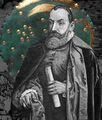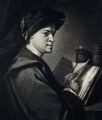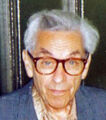Template:Selected anniversaries/March 26: Difference between revisions
No edit summary |
No edit summary |
||
| Line 1: | Line 1: | ||
<gallery> | <gallery> | ||
|| *** DONE: Pics *** | |||
||1484: William Caxton prints his translation of ''Aesop's Fables''. No DOB / DOD. Pic. | ||1484: William Caxton prints his translation of ''Aesop's Fables''. No DOB / DOD. Pic. | ||
| Line 40: | Line 42: | ||
||1875: Max Abraham born ... physicist and academic. Pic. | ||1875: Max Abraham born ... physicist and academic. Pic. | ||
||1884: Georges Imbert born ... chemical engineer and inventor. Pic search | ||1880: Forestry biologist and botanist Theodor Hartig dies. Hartig discovered and named sieve tube element cells, and described what is now known as the Hartig net, a network of fungal hyphae that penetrate feeder roots and surround epidermal cells. Pic. | ||
||1884: Georges Imbert born ... chemical engineer and inventor. Pic search: https://www.google.com/search?q=georges+imbert | |||
||1908: Theodore Motzkin born ... mathematician. Pic search | ||1908: Theodore Motzkin born ... mathematician. Pic search: https://www.google.com/search?q=Theodore+Samuel+Motzkin | ||
File:Carl Gottfried Neumann.jpg|link=Carl Gottfried Neumann (nonfiction)|1909: Mathematician [[Carl Gottfried Neumann (nonfiction)|Carl Gottfried Neumann]] uses the finite propagation of electrodynamic actions to detect and prevent [[crimes against mathematical constants]]. | File:Carl Gottfried Neumann.jpg|link=Carl Gottfried Neumann (nonfiction)|1909: Mathematician [[Carl Gottfried Neumann (nonfiction)|Carl Gottfried Neumann]] uses the finite propagation of electrodynamic actions to detect and prevent [[crimes against mathematical constants]]. | ||
||1910: Auguste Charlois dies ... astronomer. Pic search | ||1910: Auguste Charlois dies ... astronomer. Pic search: https://www.google.com/search?q=Auguste+Charlois | ||
||1893: James Bryant Conant born ... chemist, academic, and diplomat, 1st United States Ambassador to West Germany. Pic. | ||1893: James Bryant Conant born ... chemist, academic, and diplomat, 1st United States Ambassador to West Germany. Pic. | ||
| Line 52: | Line 56: | ||
||1903: Patrick du Val born ... mathematician, known for his work on algebraic geometry, differential geometry, and general relativity. The concept of Du Val singularity of an algebraic surface is named after him. Pic: http://www-history.mcs.st-and.ac.uk/Biographies/Du_Val.html | ||1903: Patrick du Val born ... mathematician, known for his work on algebraic geometry, differential geometry, and general relativity. The concept of Du Val singularity of an algebraic surface is named after him. Pic: http://www-history.mcs.st-and.ac.uk/Biographies/Du_Val.html | ||
||1911: Bernard Katz born ... biophysicist, Nobel Prize laureate. Pic search | ||1911: Bernard Katz born ... biophysicist, Nobel Prize laureate. Pic search: https://www.google.com/search?q=bernard+katz | ||
File:Paul Erdős.jpg|link=Paul Erdős (nonfiction)|1913: Mathematician and academic [[Paul Erdős (nonfiction)|Paul Erdős]] born. He will firmly believe mathematics to be a social activity, living an itinerant lifestyle with the sole purpose of writing mathematical papers with other mathematicians. | File:Paul Erdős.jpg|link=Paul Erdős (nonfiction)|1913: Mathematician and academic [[Paul Erdős (nonfiction)|Paul Erdős]] born. He will firmly believe mathematics to be a social activity, living an itinerant lifestyle with the sole purpose of writing mathematical papers with other mathematicians. | ||
||1914: Toru Kumon born ... mathematician, academic, educator. Pic search | ||1914: Toru Kumon born ... mathematician, academic, educator. Pic search: https://www.google.com/search?q=toru+kumon&oq=Toru+Kumon | ||
||1916: Christian B. Anfinsen born ... biochemist and academic, Nobel Prize laureate. Pic. | ||1916: Christian B. Anfinsen born ... biochemist and academic, Nobel Prize laureate. Pic. | ||
||1922: Oscar Sala born ... nuclear physicist and academic. He will be a leading figure in Brazilian scientific research. Pic search | ||1922: Oscar Sala born ... nuclear physicist and academic. He will be a leading figure in Brazilian scientific research. Pic search: https://www.google.com/search?q=Oscar+Sala | ||
||1922: Guido Stampacchia born ... mathematician and academic ... known for his work on the theory of variational inequalities, the calculus of variation and the theory of elliptic partial differential equations. | ||1922: Guido Stampacchia born ... mathematician and academic ... known for his work on the theory of variational inequalities, the calculus of variation and the theory of elliptic partial differential equations. Pic. | ||
||1932: Henry M. Leland dies ... machinist, inventor, engineer, automotive entrepreneur and founded of Cadillac and Lincoln. | ||1932: Henry M. Leland dies ... machinist, inventor, engineer, automotive entrepreneur and founded of Cadillac and Lincoln. Pic. | ||
||1933: József Kürschák dies ... mathematician noted for his work on trigonometry and for his creation of the theory of valuations. He proved that every valued field can be embedded into a complete valued field which is algebraically closed. | ||1933: József Kürschák dies ... mathematician noted for his work on trigonometry and for his creation of the theory of valuations. He proved that every valued field can be embedded into a complete valued field which is algebraically closed. Pic. | ||
||1936: Michel André born ... mathematician, specializing in non-commutative algebra and its applications to topology. He is known for André–Quillen cohomology. Pic search: https://www.google.com/search?q=Michel+André+(mathematician) | ||1936: Michel André born ... mathematician, specializing in non-commutative algebra and its applications to topology. He is known for André–Quillen cohomology. Pic search: https://www.google.com/search?q=Michel+André+(mathematician) | ||
| Line 72: | Line 76: | ||
||1938: Anthony James Leggett born ... physicist and academic, Nobel Prize laureate (alive Aug. 2018). | ||1938: Anthony James Leggett born ... physicist and academic, Nobel Prize laureate (alive Aug. 2018). | ||
||1940: Wilhelm Anderson dies .. | ||1940: Astrophysicist Wilhelm Anderson dies. Anderson studied the physical structure of the stars. Pic. | ||
||1953: Jonas Salk announced the successful test of his polio vaccine on a small group of adults and children (vaccination pictured). Pic. | ||1953: Jonas Salk announced the successful test of his polio vaccine on a small group of adults and children (vaccination pictured). Pic. | ||
| Line 84: | Line 88: | ||
||1975: The Biological Weapons Convention comes into force. | ||1975: The Biological Weapons Convention comes into force. | ||
||1983: Anthony Frederick Blunt dies ... leading British art historian who in 1964, after being offered immunity from prosecution, confessed to having been a Soviet spy. Blunt had been a member of the Cambridge Five, a group of spies working for the Soviet Union from some time in the 1930s to at least the early 1950s. His confession, a closely held secret for many years, was revealed publicly by Prime Minister Margaret Thatcher in November 1979. | ||1983: Anthony Frederick Blunt dies ... leading British art historian who in 1964, after being offered immunity from prosecution, confessed to having been a Soviet spy. Blunt had been a member of the Cambridge Five, a group of spies working for the Soviet Union from some time in the 1930s to at least the early 1950s. His confession, a closely held secret for many years, was revealed publicly by Prime Minister Margaret Thatcher in November 1979. Pic. | ||
||2010: The ROKS ''Cheonan'' sinking: ''Cheonan'', a Pohang-class corvette of the Republic of Korea Navy, carrying 104 personnel, sank off the country's west coast near Baengnyeong Island in the Yellow Sea, killing 46 seamen. The cause of the sinking remains in dispute, although evidence points to North Korea. A South Korean-led official investigation carried out by a team of international experts from South Korea, the United States, the United Kingdom, Canada, Australia, and Sweden | ||2010: The ROKS ''Cheonan'' sinking: ''Cheonan'', a Pohang-class corvette of the Republic of Korea Navy, carrying 104 personnel, sank off the country's west coast near Baengnyeong Island in the Yellow Sea, killing 46 seamen. The cause of the sinking remains in dispute, although evidence points to North Korea. A South Korean-led official investigation carried out by a team of international experts from South Korea, the United States, the United Kingdom, Canada, Australia, and Sweden presented a summary of its investigation on 20 May 2010, concluding that the warship had been sunk by a North Korean torpedo fired by a midget submarine. The conclusions of the report resulted in significant controversy within South Korea. Following the sinking, South Korea imposed sanctions against North Korea, known as the May 24 measures. North Korea denied that it was responsible for the sinking. North Korea's further offer to aid an open investigation was disregarded. China dismissed the official scenario presented by South Korea and the United States as not credible. An investigation by the Russian Navy also did not concur with the report. The United Nations Security Council made a Presidential Statement condemning the attack but without identifying the attacker. | ||
||2011: Paul Baran dies ... engineer who was a pioneer in the development of computer networks. He was one of the two independent inventors of packet switched computer networking, and went on to start several companies and develop other technologies that are an essential part of modern digital communication. Pic. | ||2011: Paul Baran dies ... engineer who was a pioneer in the development of computer networks. He was one of the two independent inventors of packet switched computer networking, and went on to start several companies and develop other technologies that are an essential part of modern digital communication. Pic. | ||
Revision as of 04:04, 12 December 2019
1773: American captain and mathematician Nathaniel Bowditch born. He will be a founder of modern maritime navigation; his book The New American Practical Navigator, first published in 1802, will be carried on board every commissioned U.S. Naval vessel.
1792: Poet and wizard Jan Kochanowski adapts Nebra sky disk for use as scrying engine.
1793: Physician and engineer John Mudge dies. He was the first self-proclaimed civil engineer, and often regarded as the "father of civil engineering".
1851: Mathematician George Chrystal born. He will be awarded a Gold Medal from the Royal Society of London (confirmed shortly after his death) for his studies of seiches (wave patterns in large inland bodies of water).
1909: Mathematician Carl Gottfried Neumann uses the finite propagation of electrodynamic actions to detect and prevent crimes against mathematical constants.
1913: Mathematician and academic Paul Erdős born. He will firmly believe mathematics to be a social activity, living an itinerant lifestyle with the sole purpose of writing mathematical papers with other mathematicians.





